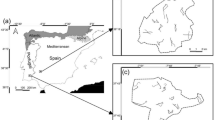Abstract
A decade back, almost 300,000 km2 of forests in India were estimated to be potential tiger habitat. But consistent degradation and unsustainable anthropogenic pressures have adversely affected tiger presence in most of the forests outside the better protected tiger reserves. Here we use Geographic Information System data to analyze the degree of vegetation loss and landscape changes over the last decade (1998–2006), and ascertain the presence of tigers in a degraded forest like the Kawal Wildlife Sanctuary, Andhra Pradesh, India, by non-invasive fecal DNA analysis. Vegetation cover maps show a clear degradation of the sanctuary within a decade. DNA analysis of scat samples reveals tiger presence in areas where closed dense forest canopy has persisted with minimal human disturbance during the last decade.



Similar content being viewed by others
References
Arandjelovic M, Guschanski K, Schubert G, Harris TR, Thalmann O, Siedel H, Vigilant L (2009) Two-step multiplex polymerase chain reaction improves the speed and accuracy of genotyping using DNA from noninvasive and museum samples. Mol Ecol Res 9:28–36
Bhagavatula J, Singh L (2006) Genotyping faecal samples of Bengal tiger Panthera tigris tigris for population estimation: a pilot study. BMC Genet 7:48
Chundawat RS, Gogate N, Johnsingh AJT (1999) Tigers in Panna: preliminary results from an Indian tropical dry forest. In: Seidensticker J, Christie S, Jackson P (eds) Riding the tiger: tiger conservation in human-dominated landscapes. Cambridge University Press, Cambridge, pp 123–129
Dinerstein E, Loucks C, Wikramanayake E, Ginsberg J, Sanderson E, Seidensticker J, Forrest J, Bryja G, Heydlauff A, Klenzendorf S, Leimgruber P, Mills J, O’Brien TG, Shrestha M, Simons R, Songer M (2007) The fate of wild tigers. Bioscience 57(6):508–514
Karanth KU, Nichols JD (2002) Monitoring tigers and their prey: a manual for researchers, managers and conservationists in Tropical Asia. Centre for Wildlife Studies, Bangalore
Karanth KU, Nichols JD, Seidensticker J, Dinerstein E, Smith JLD, McDougal C, Johnsingh AJT, Chundawat RS, Thapar V (2003) Science deficiency in conservation practice: the monitoring of tiger populations in India. Anim Conserv 6:141–146
Karanth KU, Chundawat RS, Nichols JD, Kumar NS (2004) Estimation of tiger densities in the tropical dry forests of Panna, Central India, using photographic capture–recapture sampling. Anim Conserv 7:285–290
Menotti-Raymond M, David VA, Lyons LA, Schaffer AA, Tomlin JL, Hutton MK, O’Brien SJ (1999) A genetic linkage map of microsatellites of the domestic cat (Felis catus). Genomics 57:9–23
Mondol S, Karanth KU, Kumar NS, Gopalaswamy AM, Andheria A, Ramakrishnan U (2009a) Evaluation of non-invasive genetic sampling methods for estimating tiger population size. Biol Conserv 142(10):2350–2360
Mondol S, Karanth KU, Ramakrishnan U (2009b) Why the Indian Subcontinent holds the key to global tiger recovery. PLoS Genet 5(8):e1000585. doi:10.1371/journal.pgen.1000585
Pilgrim KL, Mckelvey KS, Riddle AE, Schwartz MK (2005) Felid sex-identification based on noninvasive genetic samples. Mol Ecol Notes 5:60–61
Reed JZ, Tollit DJ, Thompson P, Amos W (1997) Molecular scatology: the use of molecular genetic analysis to assign species, sex and individual identity to seal faeces. Mol Ecol 6:225–234
Thapar V (2006) The last tiger: struggling for survival. Oxford University Press, Oxford, pp 192–193
Wikramanayake ED, Dinerstein E, Robinson JG, Karanth KU, Rabinowitz A, Olson D, Matthew T, Hedao P, Conner M, Hemley G, Bolze D (1999) Where can tigers live in the future? A framework for identifying high priority areas for the conservation of tigers in the wild. In: Seidensticker J, Christie S, Jackson P (eds) Riding the tiger: tiger conservation in human dominated landscapes. Cambridge University Press, Cambridge, pp 255–272
Williamson JE, Heubinger RM, Sommer JA, Louis EE, Barber RC (2002) Development and cross-species amplification of 18 microsatellite markers in the Sumatran tiger (Panthera tigris sumatrae). Mol Ecol Notes 2:110–112
Acknowledgments
We gratefully acknowledge the GIS Cell of the Andhra Pradesh Forest Department for providing detailed vegetation maps and georeferenced maps of Kawal Wildlife Sanctuary. We thank the Department of Biotechnology, India for financially supporting this study. We also thank the Chief Wildlife Warden, Andhra Pradesh, the Deputy Forest Officer of Kawal Wildlife Sanctuary, and all their field staff for facilitating this study.
Author information
Authors and Affiliations
Corresponding author
Additional information
Communicated by C. Gortázar
Rights and permissions
About this article
Cite this article
Reddy, P.A., Kumaraguru, A., Yadav, P.R. et al. Studies to determine presence or absence of the Indian tiger (Panthera tigris tigris) in Kawal Wildlife Sanctuary, India. Eur J Wildl Res 57, 517–522 (2011). https://doi.org/10.1007/s10344-010-0460-3
Received:
Revised:
Accepted:
Published:
Issue Date:
DOI: https://doi.org/10.1007/s10344-010-0460-3




